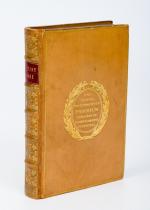[Neale, History of the Mutiny at Spithead and The Nore; With an Enquiry Into Its
History of the Mutiny at Spithead and The Nore; With an Enquiry Into Its Origin and Treatment : And Suggestions for the Prevention of Future Discontent in the Royal Navy.
London, Printed for Thomas Tegg, 1842. Small Octavo. Frontispiece Portrait of Richard Parker, XII, 415 pages. Hardcover prize-binding in full morocco with gilt lettering and ornament on spine. With Motto and ornament and motto of the Edinburgh Academy on front and rear board and bookplate of Edinburgh Academy to pastedown [Gained by John Mackenzie “For Scholarship – 9th Prize awarded by “George Ferguson (Master)”]. Very good condition with only minor signs of wear.
The Spithead and Nore mutinies were two major mutinies by sailors of the Royal Navy in 1797. They were the first in an increasing series of outbreaks of maritime radicalism in the Atlantic World. Despite their temporal proximity, the mutinies differed in character. The Spithead mutiny was a simple, peaceful, successful strike action to address economic grievances, while the Nore mutiny was a more radical action, articulating political ideals as well, which failed.
The mutinies were extremely concerning for Britain, because at the time the country was at war with Revolutionary France, and the Navy was the main component of the war effort. There were also concerns among the government that the mutinies might be part of wider attempts at revolutionary sedition instigated by societies such as the London Corresponding Society and the United Irishmen. (Wikipedia)
____________________________________________________________________
The Edinburgh Academy is a private day school in Edinburgh, Scotland, which was opened in 1824. The original building, on Henderson Row in the city’s New Town, is now part of the Senior School. The Junior School is on Arboretum Road to the north of the city’s Royal Botanic Garden.
In 2023 the school was investigated by the Scottish Child Abuse Inquiry over numerous allegations by ex-pupils of historical abuse by several staff. The Academy later issued an acknowledgement and apology.
In 1822, the school’s founders, Henry Cockburn and Leonard Horner, agreed that Edinburgh required a new school to promote classical learning. Edinburgh’s Royal High School provided a classical education, but the founders felt that greater provision was needed for the teaching of Greek, to compete with some of England’s public schools. Cockburn and Horner recruited John Russell as a co-founder and the three of them, together with other interested parties, put a proposal to the City Council for the building of a new school. The City Fathers gave their approval in 1823 and fifteen committee members were elected. (Wikipedia)
- Keywords: English History · English History – Rare · Law · Law – Rare · Maritime History · Maritime History – Rare · Maritime Law · Mutiny · Nautical · Nautical Books · Naval History · Naval Mutiny · Navigation · Prize Binding · Prize Bindings
- Language: English
- Inventory Number: 31836AB
EUR 750,--
© 2025 Inanna Rare Books Ltd. | Powered by HESCOM-Software

















